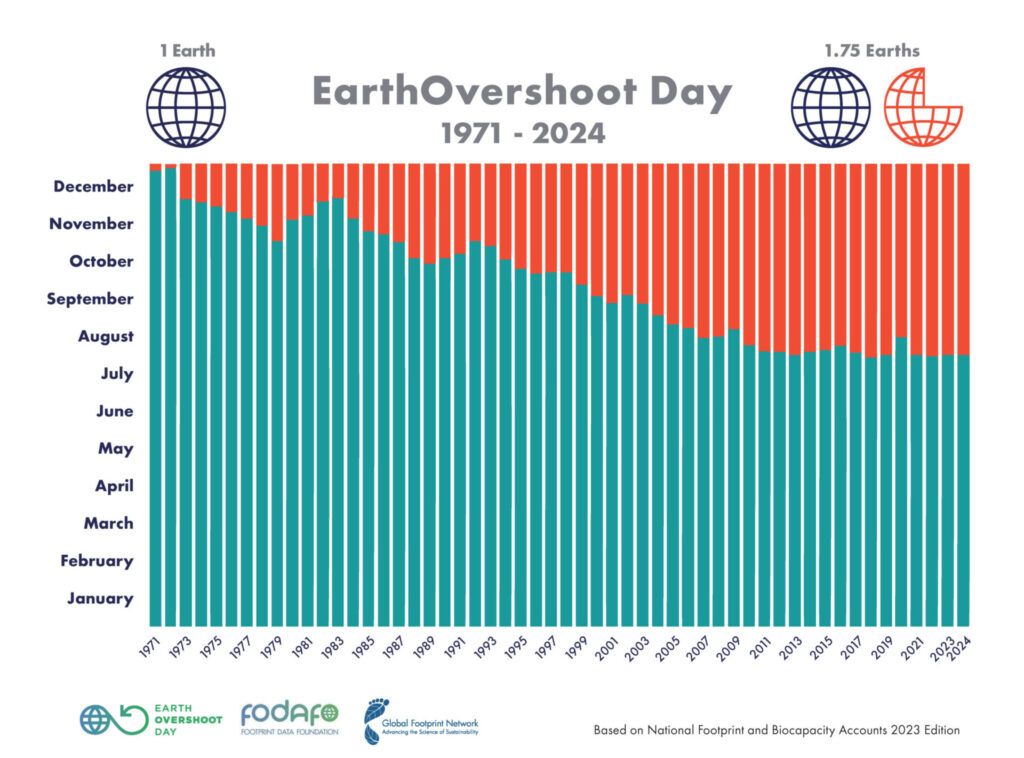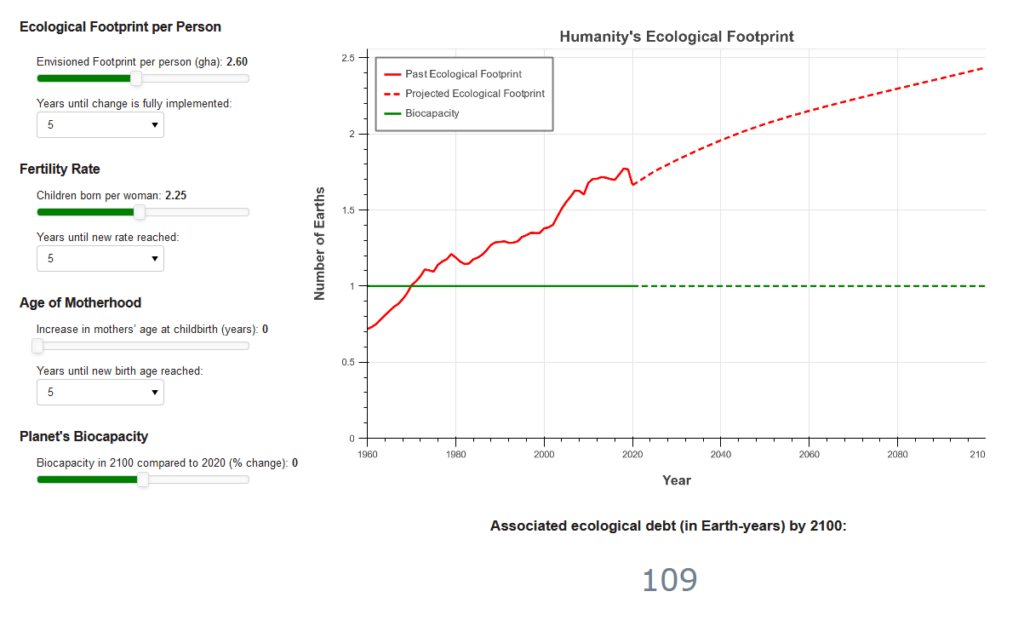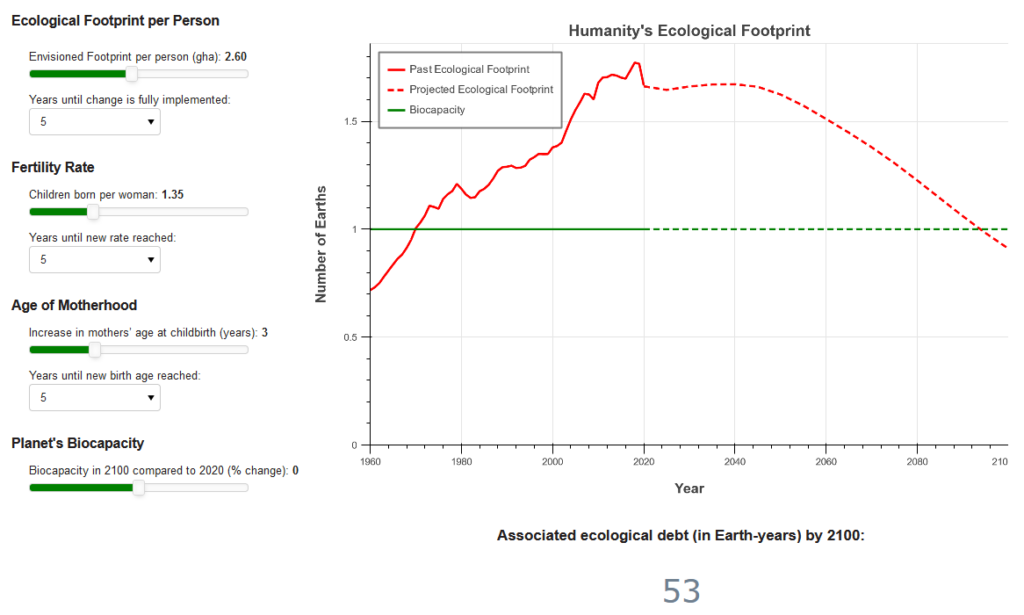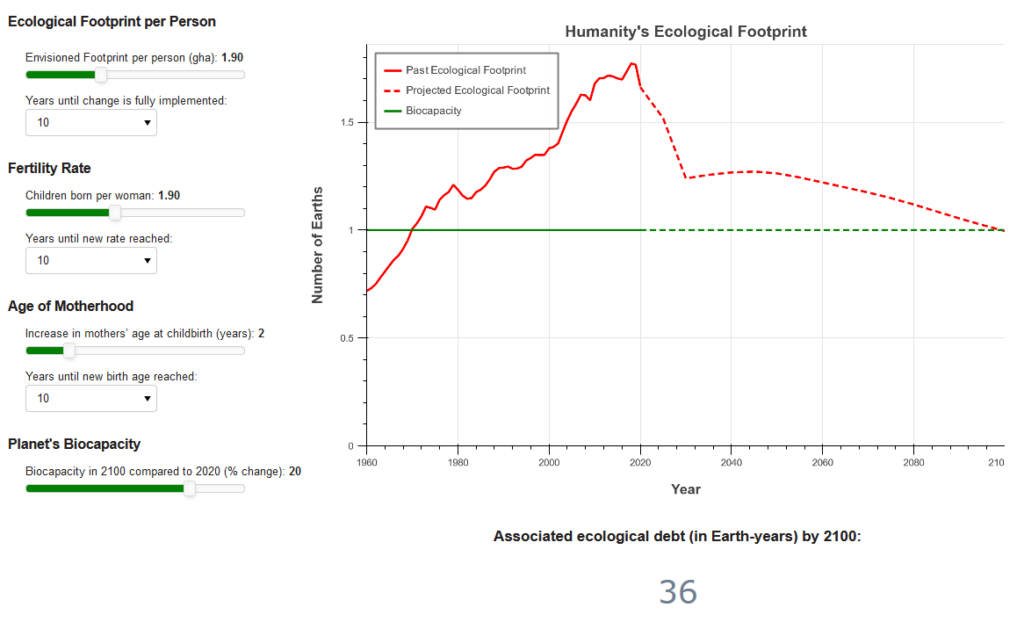Escaping overshoot: Exploring pathways to a sustainable future
Written by Olivia Nater | Published: August 7, 2024
Earth Overshoot Day fell on August 1 this year, meaning that in the first seven months of 2024, we already used up all the natural resources the planet can regenerate in a year. We need to escape overshoot by reining in unsustainable consumption and population growth. Let’s take a look at what it’ll take to get back within planetary limits.
What is Earth Overshoot Day?
Earth Overshoot Day, calculated every year by the Global Footprint Network (GFN), is a calendrical representation of the fact that humanity is using resources 1.7 times faster than what is sustainable. Another way to think of this is that we would need 1.7 Earths to satisfy our current demand without depleting resources.
To determine this figure, GFN researchers look at the planet’s biocapacity — its biologically productive land and sea area, including forests, grazing lands, cropland, fishing grounds, and built-up land. The researchers then measure how much of this we use — our population’s demand for plant-based food and fiber products, livestock and fish products, timber, space for urban infrastructure, and forest to absorb carbon dioxide emissions. This demand is known as our ecological footprint. When demand for ecological assets (our footprint) exceeds the supply (the planet’s biocapacity), we are effectively in overshoot (or ecological deficit).
At the root of ecological overshoot are unsustainable population growth and consumption patterns. Our overshoot manifests as the environmental challenges we’re familiar with, including climate change, biodiversity loss, natural resource depletion (such as of freshwater, forests, and healthy soils), and pollution.
Accumulating ecological debt
Humanity first entered overshoot in the early 1970s, and since then, the situation has gradually worsened, with Overshoot Day occurring ever earlier with each passing year. The date seems to have roughly stayed the same over the past decade, but there is currently no clear explanation for this. GFN experts state this might be due to a more sluggish world economy, increasing agricultural yields, some decarbonization efforts, and inaccuracies in available data. They stress that biocapacity is likely overestimated, while overshoot is likely underestimated.

Our failure to tackle the drivers of overshoot mean we’ve been accumulating “ecological debt,” which is the sum of annual ecological deficits. This means that even if humans were to magically disappear today á la The World Without Us, it would take many years for the Earth to restore its total biocapacity. The increasing CO2 concentrations in the atmosphere that drive climate change are an example of the build-up of our ecological debt.
The more our debt grows, the more we risk triggering dangerous environmental tipping points. In a press release for Earth Overshoot Day, Global Footprint Network board member Lewis Akenji said,
“Overshoot will end. The question is how: by design or by disaster. A planned transition gives us better security than ceding to the whims of a planet thrown off balance by overshoot.”
Escaping overshoot
GFN identifies five solution areas to end overshoot, or in other words, to move Overshoot Day back to the end of the year: restoring our planet’s natural ecosystems, improving how we generate and use energy, modifying cities, changing food systems, and ending population growth. The first of these increases the supply side, while the remaining four have a reducing effect on the demand side. Within each of these areas, GFN has calculated how much different actions would contribute to “moving the date.”
In the Energy category, charging for emissions through carbon taxes, for example, would disincentivize highly-polluting activities. GFN estimates that placing a cost of $100 per ton of carbon alone would move Earth Overshoot Day by 63 days — this makes it the most powerful solution in their solutions portfolio.
Slowing population growth by empowering women and removing barriers to reproductive health and rights is the second most powerful action identified. According to GFN calculations (based on UN population data), if the global fertility rate were 1.8 births per woman instead of today’s 2.25, and if women’s average age when they begin childbearing were delayed by two years (which could likely be achieved by ending child marriage), there would be two billion fewer people on Earth by 2050 than the more than 9.6 billion we are on track for. This would postpone Overshoot Day by a total of 49 days.
Mapping possible futures
GFN has developed a simple interactive tool in which different variables can be manipulated, including how much each of us uses, how many of us there are, and how quickly changes in consumption and family size are implemented. The tool displays how each of these changes would affect our ecological footprint trajectory relative to the planet’s biocapacity up to 2100.
[Note that the tool has not yet been updated with the latest UN population projections released last month. In addition, all input data and calculations are approximations so modeled scenarios serve more as illustrative thought experiments than realistic projections.]
1) The status quo
According to the most recent available GFN data from 2022, the estimated ecological footprint per person (a representation of consumption levels) is around 2.6 gha or global hectares (a measure of the amount of biologically productive land used). If we plug this and our current global fertility rate into the model, and assume no change in the age of mothers at first birth or the planet’s biocapacity in 2100, the gap between humanity’s projected footprint and available resources grows ever larger, and we’d have accumulated an ecological debt of 109 years by 2100!

The gap between supply and demand obviously gets worse the more we increase per capita consumption and the population growth rate. So let’s take a look at what it would take to bring our collective footprint back in line with available resources this century.
2) Reducing consumption
The average global per capita rate of 2.6 gha is unsustainable when multiplied by the 8.2 billion humans on Earth today, but it is actually still well below the per person footprint in rich countries. In the United States, for example, the average ecological footprint is a staggering 7.5 gha! [You can see how your personal footprint compares with this footprint calculator.]
If we change only the consumption variable in the scenario tool, we would need to slash this significantly in order to end overshoot. Assuming a reduction of per person consumption to just below 1.5 gha within the next 5 years, we would immediately return to sustainability, but then very quickly enter overshoot again due to continued population growth. Only around a quarter of countries analyzed have a per person footprint of less than 1.5 gha. Examples include Nicaragua (1.49), Zambia (1.21), India (1.04), and Afghanistan (0.8).
A strong reduction in global consumption rates is deeply unrealistic due to the fact that so many people still live in poverty — while ending overconsumption in the Global North is key to a sustainable future, with low- and middle-income countries (which are home to the vast majority of the world’s population) rapidly growing their economies, we can expect global per capita consumption to increase for a while yet.

3) Reducing population growth
Looking at the population side, there are two ways we can slow the growth rate in this model: by reducing the fertility rate, and by increasing the age of the onset of motherhood. If we only modify the fertility rate (and assume the change takes just five years, the minimum duration the calculator allows), we would need to reduce it to just 1.35 births per woman (which is Estonia’s current fertility rate) in order to end overshoot in 2100. Let’s say we also increase the average age of mothers at first birth by three years over the next five years via accelerated efforts to end child marriage and teen pregnancies. This would mean ending overshoot five years earlier, in 2095.
This population-only scenario is obviously not very realistic either — it would be very hard indeed to achieve such drastic changes at a global level in only five years’ time, especially as many countries are seeing stagnating progress on measures of gender equality.

4) A holistic way forward: the only realistic option
Getting where we need to go as early as possible is clearly only doable with a combination of consumption reduction and population action. Increasing the planet’s biocapacity, such as by restoring degraded land, can help too.
Let’s say we take 10 years to bring fertility down to just below replacement, at 1.9, and to increase the age of mothers at first birth by two years. Imagine also shrinking the average per person footprint to 1.9 gha, perhaps via major improvements in energy use and food systems over the next 10 years, combined with disincentives for excessive consumption (or, if you prefer, a phase-out of aggressively marketed consumerism). Large-scale reforestation and rewilding projects would increase our planet’s biocapacity by 20 percent.
The combination of these actions would lead to a return to planetary boundaries by the end of the century and arguably represents a more realistic scenario than the first two extreme scenarios.

Nevertheless, even this more “realistic” possible future represents a major deviation from the status quo. The GFN scenario tool is fun to play with but it also serves as a stark reminder of how serious our current planetary overshoot is, and how drastically we must change the way we live on this planet to achieve sustainability this century.
Over to you! What kind of footprint trajectory would you like to see over the next seven and a half decades? Have a go at the scenario tool and post a screenshot of your favorite curve on social media. Don’t forget to tag us so we can see it!

